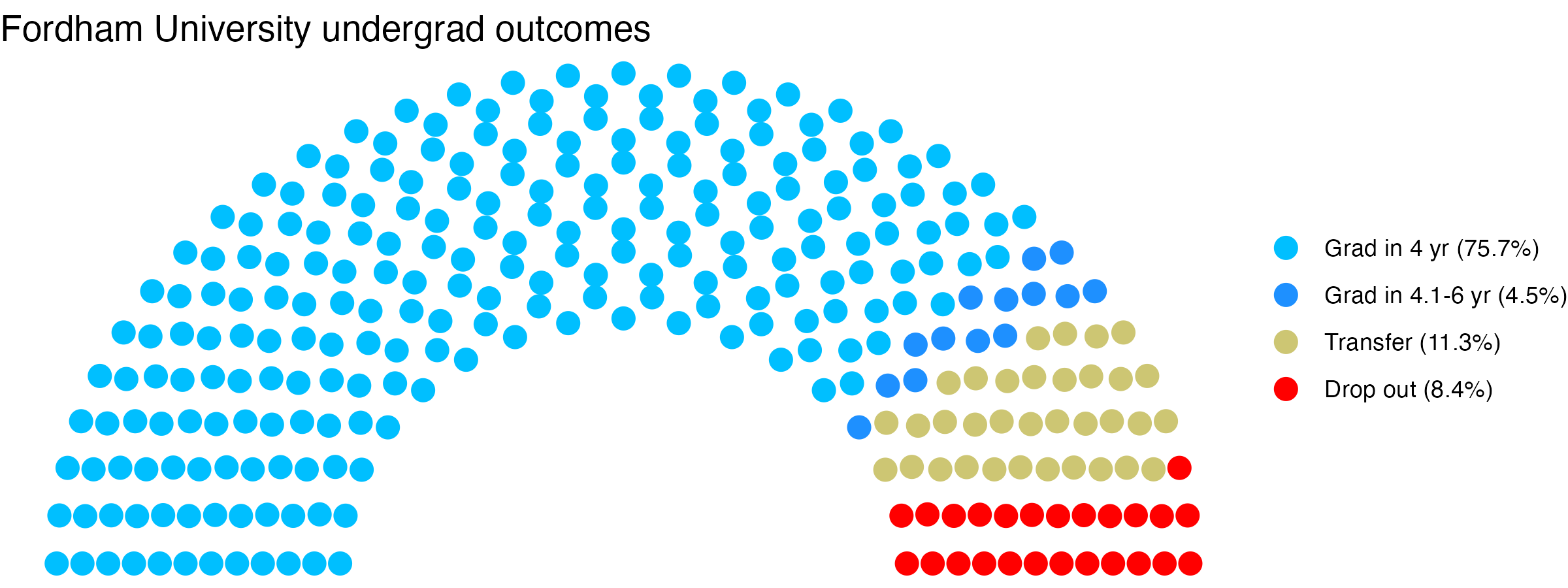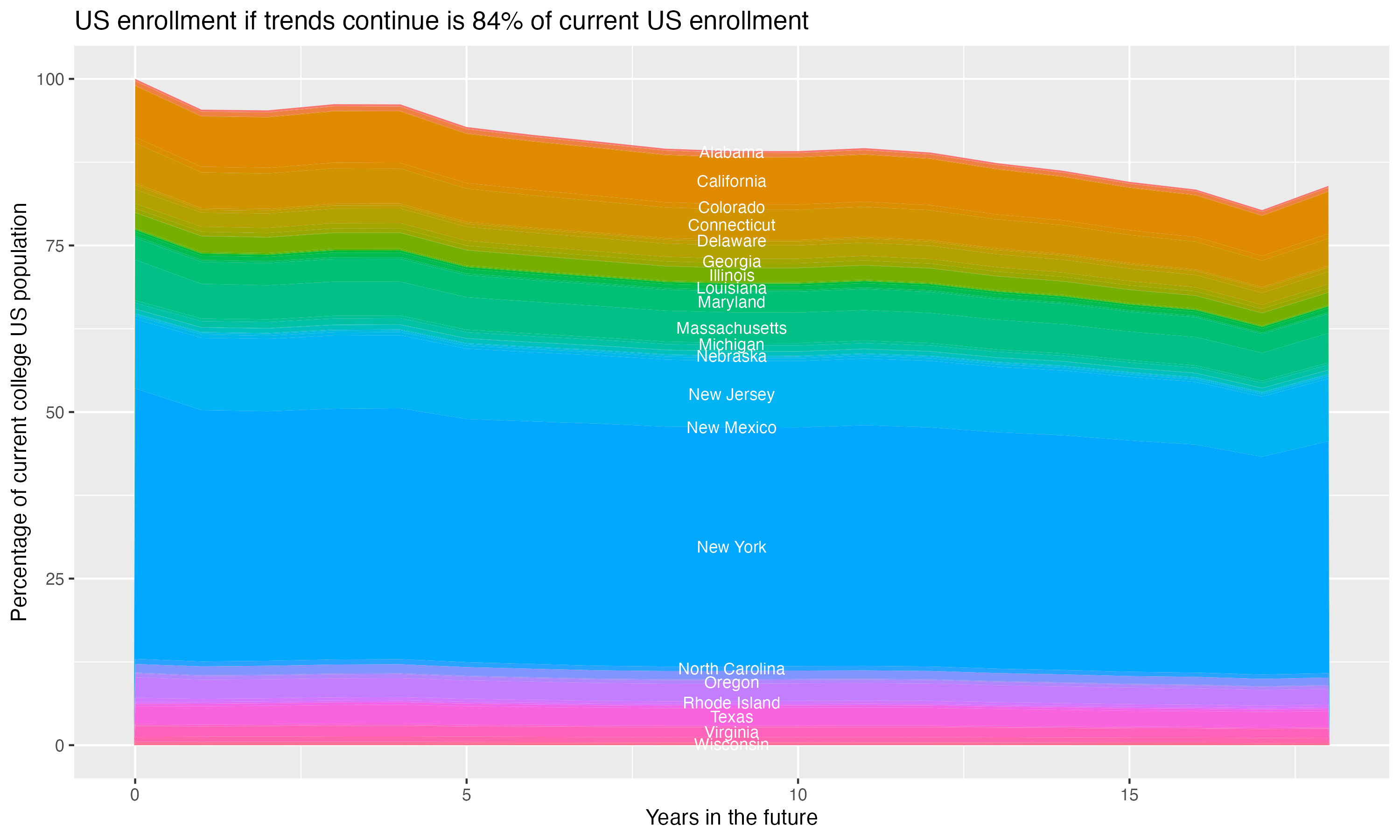Fordham University
Fordham University is located in Bronx, New York. It is a private not-for-profit, 4-year or above institution.
From Wikipedia: Fordham University is a private Jesuit research university in New York City, United States. Established in 1841, it is named after the Fordham neighborhood of the Bronx in which its original campus is located. Fordham is the oldest Catholic and Jesuit university in the northeastern United States and the third-oldest university in New York City. Founded as St. John’s College by John Hughes, then a coadjutor bishop of New York, the college was placed in the care of the Society of Jesus shortly thereafter, and has since become a Jesuit-affiliated independent school under a lay board of trustees. While governed independently of the church since 1969, every president of Fordham University between 1846 and 2022 was a Jesuit priest, and the curriculum remains influenced by Jesuit educational principles. Fordham enrolls approximately 15,300 students from more than 65 countries, and is composed of ten constituent colleges, four of which are undergraduate and six of which are postgraduate, across three campuses in southern New York State: the Rose Hill campus in the Bronx, the Lincoln Center campus in Manhattan’s Upper West Side, and the Westchester campus in West Harrison, New York. The university also maintains a study abroad center in London and field offices in Spain and South Africa. The university offers degrees in over 60 disciplines. The university’s athletic teams, the Rams, include a football team that boasted a win in the Sugar Bowl, two Pro Football Hall of Famers, two All-Americans, two Canadian Football League All-Stars, and numerous NFL players; the Rams also participated in history’s first televised college football game in 1939 and history’s first televised college basketball game in 1940. Fordham’s baseball team played the first collegiate baseball game under modern rules in 1859, has fielded 56 major league players, and holds the record for most NCAA Division I baseball victories in history. Fordham’s alumni and faculty include current President Donald Trump, United States Senators and representatives, four cardinals of the Catholic Church, several United States governors and ambassadors, a number of billionaires, two directors of the CIA, Academy Award and Emmy-winning actors, royalty, a foreign head of state, a White House Counsel, a vice chief of staff of the United States Army, a United States Postmaster General, a United States Attorney General, a President of the Federal Reserve Bank of New York, and the first female vice presidential candidate of a major political party in the United States.
Overview of institution
This, and the rest of the page, use info from the most recent year available, generally 2024.
Institution kind: Doctoral Universities: Higher Research Activity
Undergrad program: Arts & sciences plus professions, some graduate coexistence
Graduate program: Research Doctoral: Comprehensive programs, no medical/veterinary school
Enrollment profile: Majority undergraduate (see more details below)
Average net price for undergrads on financial aid: $45,368 (2.5 times the equivalent cost of Harvard).
Actual price for your family: Go here to see what your family may be asked to pay. It can be MUCH lower than the average price but also higher for some.
Size and setting: Four-year, large, highly residential
In state percentage: 37% of first year students come from New York
In US percentage: 92% of first year students come from the US
This institution has a religious affiliation of Roman Catholic
Graduation rate (within 6 years) for students seeking a Bachelors: 80.3% (this is what is usually reported as “graduation rate”)
Graduation rate (within 4 years) for students seeking a Bachelors: 75.7%
Percent of students seeking a Bachelors who transfer out of this institution: 11.3%
Student to tenure-stream faculty ratio: 18.3 (undergrads to tenure-stream faculty) [Tenure explained]
Student to faculty ratio: 17.8 (undergrads to all faculty)
Degrees offered: Bachelor’s degree, Postbaccalaureate certificate, Master’s degree, Post master’s certificate, Doctor’s degree: research scholarship, Doctor’s degree: professional practice
Schedule: Semester
Institution provides on campus housing: Yes
Dorm capacity: There are enough dorm beds for 4844 students
Freshmen required to live on campus: No
Advanced placement (AP) credits used: Yes
Disabilities: 13.20 percent of undergrads are registered as having disabilities.
Undergrad outcomes
This plot shows the outcomes for first time, full time undergraduates seeking Bachelor’s degrees (if the data are available).

Map
Comparisons
The sections below show this institution compared with others. The ones listed are ones it has identified as peers, who consider themselves peers, and/or who the federal government considers peers. If a comparison school has the same value as the focal school, its cell is grayed out. In fields where there is a common view that higher (or lower) values are better, the best values are in blue, the worst values are in red. If there isn’t a sense of a particular value being better, values are shown in varying shades of green. Arrows show where there is a signficant trend over time for a school. You can swipe across the table to see more of it; the focal school column is always visible.
- Fordham University lists these schools as ones to compare itself within federal IPEDS data, and they do the same back: Villanova University, Loyola University Chicago
- Fordham University compares itself to these institutions, but not vice versa: New York University, Northwestern University, University of Notre Dame, Northeastern University, Georgetown University, Boston University, Boston College, Syracuse University, George Washington University
- These institutions compare themselves to Fordham University, but not vice versa: Barnard College, Babson College, Baylor University, American University, Fairfield University, Bentley University, University of San Diego, Chapman University, Southern Methodist University, University of Dayton, Elon University, The New School, University of San Francisco, Creighton University, DePaul University, University of Rhode Island, University of Denver, Sacred Heart University, Saint Louis University, St. John’s University-New York, Marquette University, Loyola University Maryland, Hofstra University, Quinnipiac University, Duquesne University, Saint Joseph’s University - Philadelphia, Berklee College of Music, Belmont University, Molloy University, Seton Hall University, Adelphi University, Salve Regina University, Pace University, Centenary College of Louisiana, Manhattan University, Suffolk University, University of Hartford, Berkeley College-Woodland Park, Berkeley College-New York, Iona University, Endicott College, St. Francis College, Marymount Manhattan College, Manhattanville University, Albany Law School, Graduate Theological Union, Fielding Graduate University
Enrollment

General
Teaching
Tenure track faculty are those who are eligible for tenure. This includes both pre-tenure and tenured faculty. Once faculty get tenure, they are (generally) protected from being fired for intellectual reasons, helping to ensure their freedom in teaching and research. They can still lose their positions for misconduct, financial problems, not fulfilling their duties, or other reasons.
Non-tenure track faculty are not eligible for tenure. Some are hired one semester at a time, some have multi-year contracts. They typically have a higher teaching load than tenure track faculty, leaving less time for research or other creative endeavors. They are also easier to fire than tenured faculty. Sometimes they are external experts (a noted musician, a former senator) who are hired to teach some classes without the expected permanence of a tenure-track position.
Note that this chart uses US federal demographic data: it only has two genders and a specified set of ethnicities and races.
Having a low student to faculty ratio is considered a good thing by many, as it can mean more individual attention.
Geography
This has information on the location of the institution. See the about page for more information on what the metrics are and how they are calculated.
Financial Aid
Graduation
Note these are bachelors graduation rates in six years, not four (this is standard). Sample sizes can be small for some demographic groups with few individuals in a school, leading to large year-to-year fluctuations and often extreme values for those groups (if there are two individuals in the class with a given identity, the possible graduation rates are 0%, 50%, or 100% depending on whether zero, one, or both students graduate within six years).
Library
Libraries are changing rapidly. Note that how institutions count digital collections may vary.
Diversity
The US Census Bureau has a diversity index that goes from 0 to 1. In their words, “A 0-value indicates that everyone in the population has the same racial and ethnic characteristics. A value close to 1 indicates that everyone in the population has different racial and ethnic characteristics.” This uses their formula, but with the resolution available for the federal IPEDS data (which does not separate for a given demographic group whether members identify as Hispanic or not). This metric is about heterogeneity within the population, not the proportion of the population that comes from historically excluded groups.
Following the practice of the census, the index is multiplied by 100 to give the percentage probability a random pair of individuals will have a different background. Most institutions argue that diversity is a benefit, so by default a higher number is listed as better, but there may be cases where this measure does not reflect the mission of a college (for example, 70% of the students at a tribal college or university may be American Indian: that could be low-scoring by this metric but should not be read as “bad” given the institution’s mission).
These numbers are based on the most recent year available, generally 2024, which predates effects of the US Supreme Court’s striking down of affirmative action. This has often changed, sometimes dramatically, the incoming student demographics at some institutions.
Overall diversity
Freshman profile
Demographic data for first time degree-seeking students. Note that this uses US federal demographic data: it only has two genders and a specified set of ethnicities and races.
Freshman geography
Test scores
SAT scores
ACT scores
Majors
This presents information on the number of majors and the median earnings one and five years after graduation for people who got a degree from this institution in that field. The earnings are for those who are working and not enrolled in further education. The earnings data (from the federal college scorecard) also has information on earnings for those categorized as ‘MALE’ and ‘NOMALE’ – for readability, these are recategorized here as “Men” and “Women”, respectively, which adopts the gender binary used in other federal data. “W/M earnings ratio” is the median earnings of women divided by men, as a percentage.
Bachelors
Masters
Doctorate
Certificate
Associates
Demographic cliff
There is a concern that giving changing US demographics, the number of students in the age groups who most commonly attend four year colleges will drop off, decreasing overall enrollment. This is often referred to as the “demographic cliff”, and it can be a concern for colleges concerned about the risk of falling enrollment. For this section, the analysis uses US census data on the number of people in each state by age, and the proportion of students that come from each state for this particular college, to crudely model what will happen if everything remains constant except the demographic change in the population of 18 year olds in each year – it does not account for things like the college increasing its admission rate, attracting more students from states without the same demographic changes or from other countries, or changes in the proportion of students who go to college.
